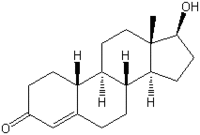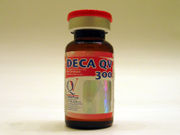To the Editor:
Casaburi and colleagues recently reported a randomized controlled trial exploring the effect of testosterone supplementation in men with COPD with or without additional resistance training during respiratory rehabilitation (1). While conducting a systematic review that included this question (2), we noted a few issues for which readers would require clarification.
A "screening" criterion was serum testosterone of ≤ 400 ng/dl. However, the mean serum testosterone level was 408 ng/dl in patients randomized to testosterone + resistance training and between 277 and 302 ng/dl in the other three groups. In addition, standard deviations varied greatly between the four groups (from 89 to 154). It is also stated that 44% of all patients had levels above 400 ng/dl at baseline. Thus it seems that the "screening" and actual inclusion criteria were not identical. An explanation why this was not the case and what the actual inclusion criteria were could help to answer our concerns. Another explanation for differences between the testosterone levels at screening and baseline would be that testosterone measurements had poor reproducibility. In that case, repeated testosterone levels may have prevented enrolment of patients for whom this intervention was not intended. The high baseline levels in one group and the lower levels in the other groups also complicate drawing conclusions about patient profiles to which the results apply.
Important baseline imbalances in FEV^sub 1^, peak work rate, and constant work rate existed between patient groups. These problems are likely to originate from the small sample sizes that limit the likelihood of successful randomization. It is inappropriate to test baseline imbalances for statistical significance in a randomized controlled trial (3). Statistical adjustment for baseline imbalances in clinical trials is in order when randomization fails to achieve balanced groups (4). Because randomization did not result in similar distributions for important variables in this trial, the authors should have corrected statistically for these baseline imbalances.
Casaburi and coworkers state they are the first to report on the combined effect of androgenic steroid supplementation and rehabilitation in patients with COPD. We would like to alert readers to the trial by Creutzberg and colleagues (5) that assessed the supplemental benefit of nandrolone during respiratory rehabilitation. The authors found no significant differences in improvement between groups in terms of muscle function, exercise capacity, and health status. The latter study included an outcome that is important to patients.
Conflict of Interest Statement: M.A.P. does not have a financial relationship with a commercial entity that has an interest in the subject of this letter; H.J.S. does not have a financial relationship with a commercial entity that has an interest in the subject of this letter.
MILO A. PUHAN
Horten Centre, University of Zurich
Zurich, Switzerland
HOLGER J. SCHÜNEMANN
McMaster University
Hamilton, Ontario, Canada
and
Italian National Cancer Institute Regina Elena
Rome, Italy
References
1. Casaburi R, Bhasin S, Cosentino L, Porszasz J, Somfay A, Lewis MI, Fournier M, Storer TW. Effects of testosterone and resistance training in men with chronic obstructive pulmonary disease. Am J Respir Crit Care Med 2004;170:870-878.
2. Puhan MA, Schünemann HJ, Frey M, Bachmann LM. Value of supplemental interventions to enhance the effectiveness of physical exercise during respiratory rehabilitation in patients with COPD: a systematic review. Respir Res 2004;5:25.
3. Assmann SF, Pocock SJ, Enos LE, Kasten LE. Subgroup analysis and other (mis)uses of baseline data in clinical trials. Lancet 2000;355:1064-1069.
4. Altman DG. Schulz KF, Moher D, Egger M, Davidoff F, Elbourne D, Gotzsche PG, Lang T. The revised CONSORT statement for reporting randomized trials: explanation and elaboration. Ann Intern Med 2001; 134:663-694.
5. Creutzberg EC, Wouters EF, Mostert R, Pluymers RJ, Schols AM. A role for anabolic steroids in the rehabilitation of patients with COPD? A double-blind, placebo-controlled, randomized trial. Chest 2003;124:1733-1742.
From the Authors:
We are pleased to respond to Drs. Puhan and Schünemann regarding our study (1).
It deserves to be stressed that our trial studied short-term effectiveness of testosterone, strength training, and their combination in improving muscle mass and strength. It was a single-center trial; this facilitated standardizing interventions and outcome measurements but limited sample size. We emphasized that our results, though quite encouraging, deserve further investigation in larger studies of longer duration.
In this initial investigation of testosterone administration to men with COPD, we focused on men whose testosterone level was somewhat low (though normal ranges are difficult to define). However, recent work has shown that the dose-response relationship to testosterone supplementation is linear (2), raising the possibility that physiologic responses may not depend strongly on baseline levels. As was clearly stated, patients were entered into the study based on testosterone level at initial screening (≤ 400 ng/dl). As good experimental design dictates, serum samples from all study phases were later batch analyzed, with the sample drawn immediately before randomization defined as the baseline level. As a result, 29% of subjects had baseline levels above 400 ng/dl, but only 13% had values above 450 ng/dl. (Drs. Puhan and Schunemann misread our results: 44% of the 85 screened patients had testosterone > 400 ng/dl.)
We present 45 baseline descriptors of this study population. Drs. Puhan and Schünemann focus on three variables that they feel exhibit "important baseline imbalances" among the four groups. They suggest statistical adjustment for these imbalances. However, the paper they cite (3) as supporting such adjustments deals with clinical trials with, on average, 10 times our study population. Further, in this paper unadjusted analyses are recommended unless baseline factors for covariate adjustment are prededared on the basis of their strong relation to outcome. We believe that the modest differences among groups in these three variables (that in no case reaches statistical significance) would not be expected to influence change in either body composition or muscle strength with these interventions. We reassert that our randomization procedures resulted in well-balanced study groups.
We correctly stated that ours was the first demonstration that strength increases accompany androgenic steroid supplementation in COPD. The work of Creutzberg and coworkers (4) deserves citation, but it was published while our paper was under review. That study confirms our finding that androgenic steroids increase lean body mass, but it fails to detect enhanced muscle strength, perhaps because a group receiving anabolic steroids without exercise training was not included.
Conflict of Interest Statement: R.C. has been an investigator in a multicentered trial of Oxandrolone (an oral steroid) in COPD sponsored by Biotechnology General Corporation (total payments to site of approximately $75,000); L.C. does not have a financial relationship with a commercial entity that has an interest in the subject of this letter; J.P. does not have a financial relationship with a commercial entity that has an interest in the subject of this letter; M.I.L. does not have a financial relationship with a commercial entity that has an interest in the subject of this letter; M.F. does not have a financial relationship with a commercial entity that has an interest in the subject of this letter; T.W.S. does not have a financial relationship with a commercial entity that has an interest in the subject of this letter.
RICHARD CASABURI
LOUIS COSENTINO
JANOS PORSZASZ
Los Angeles Biomedical Institute at Harbor-UCLA Medical Center
Torrance, California
MICHAEL I. LEWIS
MARIO FOURNIER
Cedars-Sinai Medical Center
Los Angeles, California
THOMAS W. STORER
El Camino College
Torrance, California
References
1. Casaburi R, Bhasin S. Cosentino L, Porszasz J, Somfay A, Lewis MI. Fournier M, Storer TW. Effects of testosterone and resistance training in men with chronic obstructive pulmonary disease. Am J Respir Crit Care Med 2004; 170:870-878.
2. Bhasin S, Woodhouse L, Casaburi R, Singh AB, Bhasin D, Berman N, Magliano L, Dzekov C, Dzekov J, Bross R, et al. Testosterone dose-response relationships in healthy young men. Am J Physiol Endocrinol Metab 2001;281:E1172-E1181.
3. Assmann SF, Pocock SJ, Enos LE, Kasten LE. Subgroup analysis and other (mis)uses of baseline data in clinical trials. Lancet 2000;355:1064-1069.
4. Creutzberg EC, Wouters EF, Mostert R, Pluymers RJ, Schols AM. A role for anabolic steroids in the rehabilitation of patients with COPD? A double-blind, placebo-controlled, randomized trial. Chest 2003;124:1733-1742.
Copyright American Thoracic Society Aug 1, 2005
Provided by ProQuest Information and Learning Company. All rights Reserved



